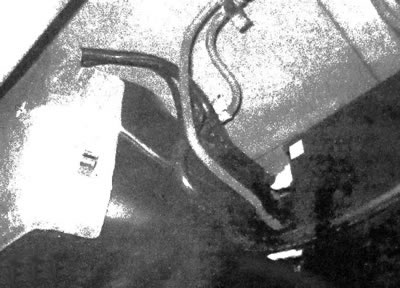Warning: When performing routine inspection and maintenance of fuel system components, certain precautions must be observed. Work in well-ventilated areas, and do not allow open flames or light bulbs without a protective hood in the work area. Do not allow gasoline to come into contact with your skin. Wear rubber gloves. If gasoline gets on your skin, wash it off with running water and soap. Immediately wipe up any spilled fuel and store any material that has absorbed it in a place where there is no risk of fire. Before exposing elements, relieve pressure in the system (see chapter 4). Have a Class B fire extinguisher on hand and operate the system with special eye protection.
1. If you notice the smell of fuel while driving a vehicle or when it is exposed to sunlight, immediately inspect the fuel system.
2. Remove the fuel filler cap and inspect it for signs of damage or corrosion. There should be a clear imprint of the sealing surface on the cover gasket. If the gasket surface shows signs of wear or corrosion, replace the cover.
3. Inspect the fuel supply and return lines for cracks. Make sure that the metal fuel lines are securely connected to the injectors.
Warning: the vehicle has a forced fuel injection system. Before servicing fuel equipment, it is necessary to relieve the system pressure. IN chapter 4 the corresponding procedure is described.
4. On 4.2L engines, the fuel injectors are invisible. Signs of a leak include the presence of fuel impurities in the engine oil or a long time to start the engine, which is accompanied by the appearance of black smoke from the exhaust pipe.
5. Since some elements of the system, such as the fuel tank and large sections of the forward and return fuel lines, are located on the underbody of the vehicle, it is recommended to lift it with a lift, which will provide improved visibility during inspection. If it is not possible to use a lift, lift the car with a jack and install vertical supports.
6. After raising the vehicle and ensuring its stability, inspect the fuel tank and filler neck for cracks, holes, or other damage. The connection between the filler neck and the fuel tank requires the most careful attention. Sometimes the rubber neck leaks due to loose clamps or wear of the material. Make sure that the tank is securely attached to the car body by inspecting its brackets
Warning: Do not attempt to repair the fuel tank yourself (Only replacement of rubber parts is permissible). Exposure to an open flame from a welding torch can cause fuel vapors in the tank to explode.
7. Carefully inspect the metal and rubber sections of the fuel lines connected to the fuel tank (see illustration). Inspect for loose connections, worn hoses, pinched fuel lines and other problems. Carry out the necessary replacement as described in chapter 4.

18.7 Inspect the fuel tank mounting straps, as well as any possible fuel and vent lines
8. The smell of fuel can also come from connections and components of the fuel vapor recovery system. This system is designed to accumulate vapors in a carbon adsorber and then direct them into the intake tract, from where the vapors mixed with air enter the combustion chambers.
9. The most common sign of a problem with the fuel vapor recovery system is the presence of a persistent smell of fuel emanating from the adsorber. If there is a smell of fuel, after ruling out that its source is located in the areas the inspection of which is described above, it is necessary to inspect the adsorber and its connections to the hoses (see _ chapter 6).
